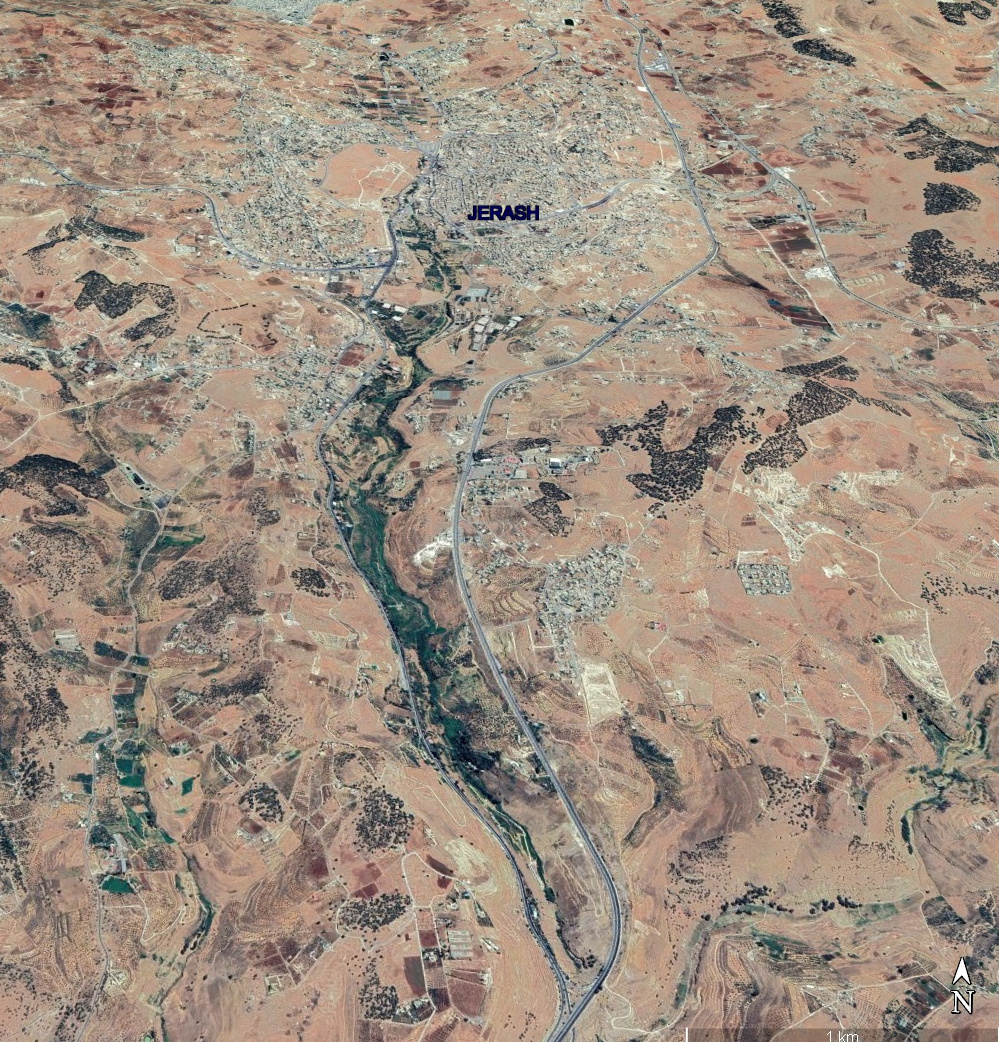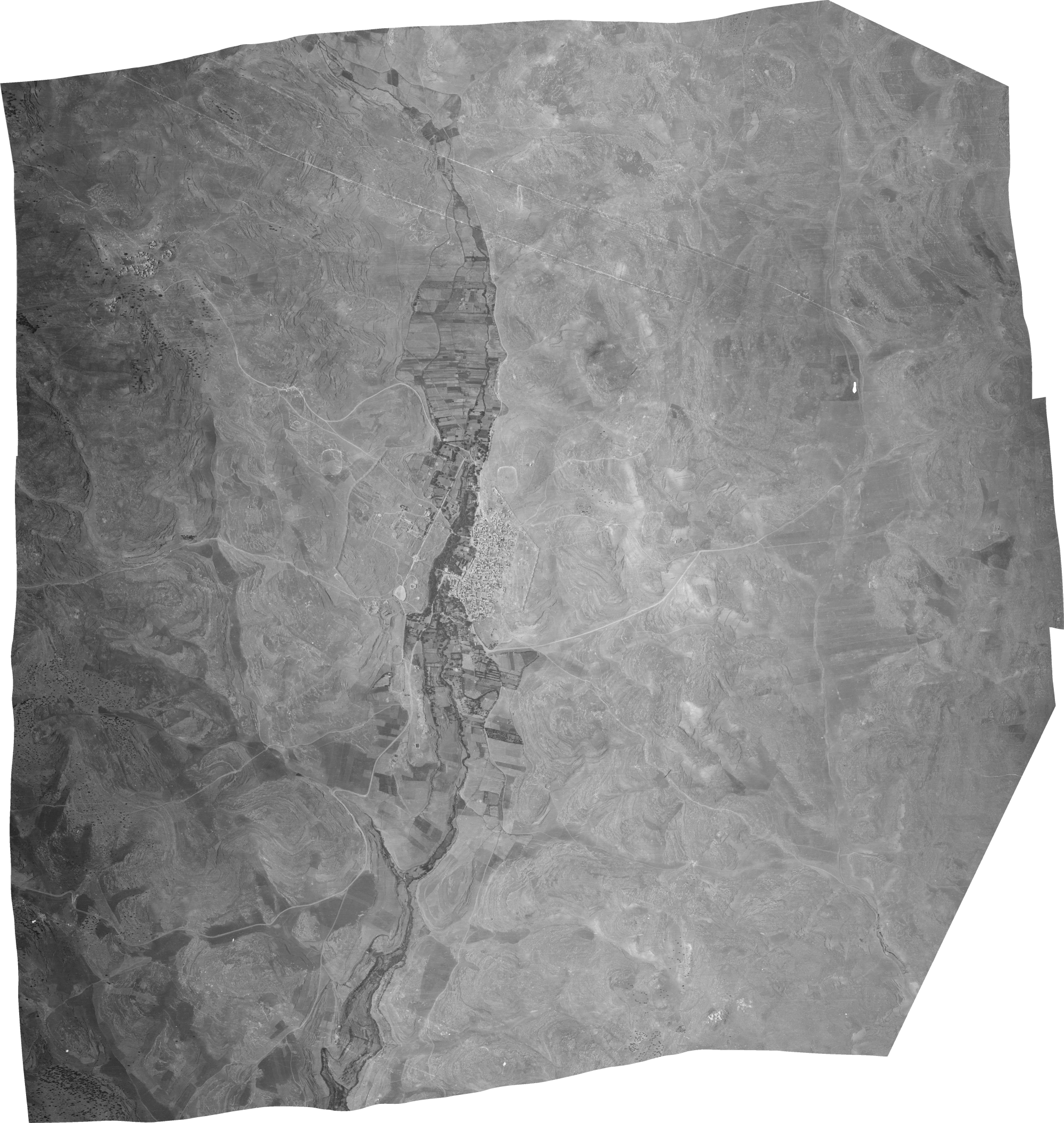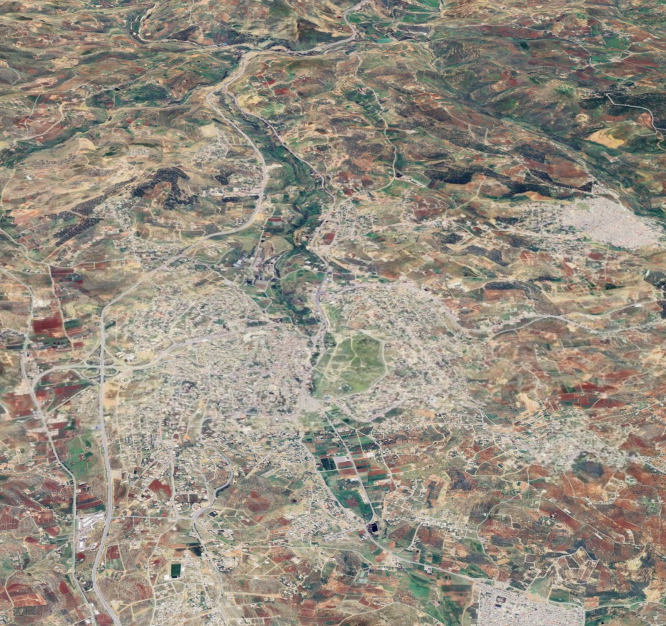Jerash - Wadi Suf
 Oblique Satellite View of Jerash and Environs
Oblique Satellite View of Jerash and EnvironsGoogle Earth
| Transliterated Name | Source | Name |
|---|---|---|
| Chrysorrhoas River | Ancient Greek | |
| Wadi Jerash | Modern Arabic | |
| Wadi Suf | Arabic |
The extreme topography of Jerash provides a special case. The steep Wadi Jerash, which is the modern name of the river-valley, literally cuts the city into two parts, an eastern and a western part; physical communication between the parts was only possible by bridges. The springs of the Chrysorrhoas lie in the region of Suf, about 6 km northwest of the city center of Jerash. The Chrysorrhoas flows into Wadi Zarqa (ancient Jabbok), approximately another 6 km southeast of the city center. Wadi Zarqa finally flows into the river Jordan. The riverine environment of Jerash thus forms a well-defined Mediterranean microregion, the resources of which are related to the river (Horden and Purcell 2000; Kennedy 2007). The catchment area of the Chrysorrhoas covers 57.1 km2 (FIGURE 1).
The area between the springs of Suf and modern Jerash is a region with moderate topography that was and is suitable for agricultural production (FIGURE 6). The wadi—which here refers to an entire hydrological system and not only an intermittent stream as the term is sometimes used, with its immediate surroundings in Suf and until what is today Muheyyem Suf — shows strong traces of landscape management in various historical periods. This area most likely relates to an association of “gardeners of the upper valley” known through a Roman-period inscription. The inscription’s content underlines the importance of agricultural cultivation in the riverine hinterland and the impact it had on the social organization of the city (Gatier 1985, 310–312; Lichtenberger and Raja 2016a, 110–111; Seigne 2004, 176). Today, the area of the upper wadi is intensively managed with agricultural terraces on the slopes (on agricultural terraces in the Mediterranean see, for example, Countryman, Carrier, and Kane [2012], Foxhall [1996], Langdon [2013], Lohmann [1993, 196–219], Price and Nixon [2005], Rackham and Moody [1992], and Șanlı-Erler [2006, 127]. ...
- from Jerash - Introduction - click link to open new tab
- Orthophoto of Wadi Jerash
from 1953 from Jerash Aerial Photos at figshare
- Wadi Suf in Google Earth
- General Plan of Jerash
from Wikipedia
- Fig. 1 Geologic Map of
Wadi Suf along with locations of the 3 sampled profiles from Lichtenberger et. al. (2019)

 Wadi Suf location and region with indication of the three sampled profiles.
Modified from Hammouri and El-Naqa (2008).
Wadi Suf location and region with indication of the three sampled profiles.
Modified from Hammouri and El-Naqa (2008).
Lichtenberger et. al. (2019) - Fig. 3 Soil deposits in
the Upper Wadi Jerash from Lichtenberger and Raja (2018)

 Fig. 3
Fig. 3
Soil deposits in the Upper Wadi Jerash
(after Holdridge et al. 2016: Fig. 3, graphics: L. Hilmar,Grafisk Tegnestue, Moesgaard Museum).
Lichtenberger and Raja (2018))
- from Chat GPT 4o, 26 June 2025
- from Lichtenberger et al. (2019)
| Profile | Stratigraphy | Date | Description |
|---|---|---|---|
| 2 (Upper Wadi) | Fluvial over bedrock | post 640 ± 240 CE | Four major phases of fluvial deposition with evidence for changing flow regimes and sediment sources, ending before colluvial deposition begins at 760 ± 40 CE. |
| 2 (Upper Wadi) | Colluvial | from 760 ± 40 CE | Scattered OSL signals indicate dominant colluvial deposition, interpreted as slope degradation following the 749 CE earthquake and collapse of terrace systems. |
| 3 (Mid Wadi) | Fluvial & colluvial | ceased before 1400 ± 60 CE | Similar sequences of alternating fluvial and colluvial deposition, though distinct from upper wadi in timing; later colluviation tied to erosion and terrace collapse by 1400 CE. |
| LW1 (Lower Wadi) | Fluvial | from 510 ± 310 BCE | Early fluvial sedimentation interpreted as related to early urbanization of Jerash; four phases with short- term intensity shifts. Colluvial deposits begin ca. 760 ± 40 CE, tied to earthquake-induced slope failure. |
Lichtenberger et. al. (2019) examined three soil profiles in Wadi Suf using OSL (Optically Stimulated Luminescence). The 3 soil profiles were described as follows:
OSL sediment profiles for the three analyzed stratigraphies highlight the movement of fluvial and colluvial sediment into and through the wadi.These profiles were interpreted as follows:
Profile 2
Figure 7 showing sediment-luminescence profiles from Profile 2, indicates fluvial deposition from 180 cm below the surface superimposed on bedrock at 300 cm. Breaks in the linear pattern of luminescence signal, indicating change in flow regimes, together with switching of intensities between OSL and IRSL net signal, indicating change in sediment composition, suggest an episodic nature of fluvial deposition; four major phases have been identified in this stratigraphy. Above the fluvial deposits, the colluvial deposits are characterized by more scattered signal intensities and indicate that as the wadi filled, colluvial deposition became a dominant process.
Profile 3
Four phases of fluvial deposition with superimposed colluvial deposition, with elements of soil stability, are also evident in Profile 3 (FIGURE 8), although based on the absolute-dating evidence (TABLE 1; below) these more rapid accumulations are not the same occurrences as in the upper wadi (Profile 2).
Profile LW1
Similarly, Profile LW1 (FIGURE 9) contains sequences of fluvial events of varying intensities and give evidence of short-term switches of intensity within longer-term trends. Later colluvial deposits are again superimposed on the fluvial sediments.
Our initial interpretation sequence for the upper-wadi profile is of a freely flowing river and an intact landscape with no sediment accumulation until A.D. 640 ± 240. After this time, fluvial sedimentation and wadi infilling commences, indicating increasing degradation of the upper catchment. Above the fluvial deposits the onset of colluvial activity at A.D. 760 ± 40 marks an acceleration of land degradation in the upper wadi. Further analyses are required to securely date the earlier fluvial history in the mid-wadi location, but this process had ceased by A.D. 1400 ± 60, after which colluvial accumulation indicates accelerated land degradation. Fluvial sediment accumulations in the lower wadi commence from 510 ± 310 B.C., paralleling OSL dates from soils underlying Jerash city (Cresswell et al. 2018), through to the statistically derived A.D. 760 ± 40 date (see above) when colluvial processes become more dominant.
These chronologically based analyses identify critical junctures in the formation of the wadi that require explanation. What stimulated the commencement of fluvial deposition at the 510 ± 310 B.C. OSL marker in the lower wadi, downstream from the city, and again at the A.D. 640 ± 210 OSL marker (and given its stratigraphic position, prior to A.D. 760 ± 40) in the upper wadi? Perhaps the beginnings of urbanization, at the latest in the 2nd century B.C., when the city was founded as a Seleucid settlement, explains the first. The beginnings of hinterland agricultural decline, as a herald of city decline, prior to the earthquake that destroyed the city in A.D. 749 coincides with the dry period revealed by palaeoclimatological studies, that appears to have struck the eastern Mediterranean in full force A.D. 500–750 (Büntgen et al. 2016; Enzel et al. 2003; Finné et al. 2011; Harper and McCormick 2018; Issar and Zohar 2007, 215–216; Orland et al. 2009). This period of gradually increasing environmental stress also saw a series of known shocks to the socioeconomic system due to the dramatic climate anomaly of A.D. 536–550 (Newfield 2018), the recurring pandemic known as the Justinianic plague commencing in A.D. 540–541 (Meier 2016), and the century of Roman-Sassanian and then Roman-Arab wars unfolding in this region in the period A.D. 540–640. While current assessments reveal that urban centers of the southern Levant showed remarkable resilience in the face of this series of calamities (Haldon 2016; Walmsley 2007), it was also a period of declining long-distance trade and increased pressure of taxation (Haldon 1990). In Jerash, mass-graves with remains of victims of the Justinianic plague have been uncovered in the hippodrome (Kehrberg and Ostrasz 2017).
What stimulated the parallel onset of colluvial deposition A.D. 760 ± 40 in the upper- and lower-wadi locations and its later occurrence A.D. 1400 ± 60 in the mid-wadi location? Perhaps the best explanation for the earlier phase in upper and lower wadi is the A.D. 749 earthquake, resulting in failure of the slope-terrace system and associated irrigation due to shake and liquefaction, together with loss of hinterland land management as agricultural demand from the city declined. The earthquake came at a time when climatic conditions were more difficult than they had ever been during the urban history of Jerash with a series of misfortunes culminating in the Umayyad-Abbasid war A.D. 747–750. The post A.D. 1400 ± 60 sediments also suggest slope and terrace failure
| Effect | Location | Image(s) | Description |
|---|---|---|---|
|
Wadi Suf
 Wadi Suf location and region with indication of the three sampled profiles.
Modified from Hammouri and El-Naqa (2008).
Wadi Suf location and region with indication of the three sampled profiles.
Modified from Hammouri and El-Naqa (2008).
Lichtenberger et. al. (2019) |

 Fig. 3
Fig. 3Soil deposits in the Upper Wadi Jerash (after Holdridge et al. 2016: Fig. 3, graphics: L. Hilmar,Grafisk Tegnestue, Moesgaard Museum). Lichtenberger and Raja (2018)) |
|
-
Earthquake Archeological Effects chart
of Rodríguez-Pascua et al (2013: 221-224)

 Earthquake Archeological Effects (EAE)
Earthquake Archeological Effects (EAE)
Rodríguez-Pascua et al (2013: 221-224)
| Effect | Location | Image(s) | Description | Intensity |
|---|---|---|---|---|
|
Wadi Suf
 Wadi Suf location and region with indication of the three sampled profiles.
Modified from Hammouri and El-Naqa (2008).
Wadi Suf location and region with indication of the three sampled profiles.
Modified from Hammouri and El-Naqa (2008).
Lichtenberger et. al. (2019) |

 Fig. 3
Fig. 3Soil deposits in the Upper Wadi Jerash (after Holdridge et al. 2016: Fig. 3, graphics: L. Hilmar,Grafisk Tegnestue, Moesgaard Museum). Lichtenberger and Raja (2018)) |
|
|
Holdridge, G., Kristiansen, S.M., Lichtenberger, A., Raja, R. & Simpson, I.A. (2016). City and wadi: exploring the
environs of Jerash, Antiquity, 91 (358)
Lichtenberger, A. & Raja, R. (2016). Living with and on the river-side. The example of Roman Antioch-on-theChrysorrhoas-formerly-called-Gerasa.
In: Madsen, J.K., Andersen, N.O. & Thuesen, I. (ed.). Water of Life.
Proceedings of the Danish Institute in Damascus, 11. Copenhagen: Orbis, pp. 98-115.
Lichtenberger, A. and Raja, R. (2018) River archaeology and urban resilience in Jerash in
Urban network evolutions - Towards a high-definition archaeology
Lichtenberger, A., et al. (2019). "Urban-Riverine Hinterland Synergies in Semi-Arid Environments:
Millennial-Scale Change, Adaptations, and Environmental Responses at Gerasa/Jerash."
Journal of field archaeology 44(5): 333-351.
Parayre, D. (ed.). (2016). Le fleuve rebelle. Géographie historique du moyen Oronte d’Ebla à l’époque médiévale. Beyrouth:
Presses de l’Ifpo.
Jerash is bisected by the Chrysorrhoas river. The modern name for the river-valley which
surrounds this river is Wadi Jerash.


